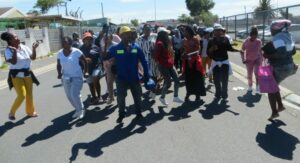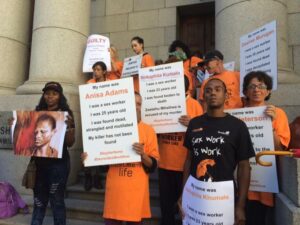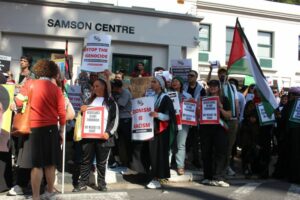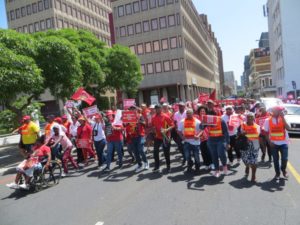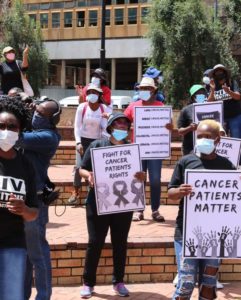
Activists and concerned residents of Cape Town, led by the African Climate Alliance, picketed outside the ongoing African Mining Indaba taking place at the Cape Town International Conference Centre in solidarity with the families of the zama-zamas who died in Stilfontein. Following a court order, the government was forced to facilitate a rescue operation at the mine. The miners had been trapped underground for months without food, water and medication after supplies were cut off by authorities. In January, 240 miners were rescued and 78 bodies were retrieved from the abandoned Buffelsfontein Gold Mine.
There are over 6,000 unrehabilitated mines in South Africa according to a recent report by the auditor-general. The report states that the government – the Department of Mineral and Petroleum Resources in particular – is decades behind schedule. “[I]t will take approximately 69 years to rehabilitate the remaining 229 derelict and ownerless asbestos mines,” says the report.
The activists feel that the extent of unrehabilitated mines and the abject failure by government to remedy the situation contributed directly to the Stilfontein seige. Zethu Hlatshwayo from the National Association of Artisanal Miners told Elitsha that they have been engaging the government on the issue of abandoned mines for years. After failing for many years to act, “what the government has done now with Operation Vala Umgodi [close the hole] is to get the police to guard the open shafts instead of rehabilitating the mines,” said Hlatshwayo.
Liziwe McDaid from Green Connection said that there is a phenomenon where mine owners sell off the mines to junior partners who do not have the funds to rehabilitate the mines.
Petrus Moshe, an activist based in Klerksdorp, which is about 10 kilometres from Stilfontein, told Elitsha that in 2002, they reported an open shaft in Stilfontein to the ministry of mining. Moshe said it took a concerted effort on their part to have the shaft closed. “There are still lots of open shafts in the Klerksdorp area,” he said.
Court orders government to rescue the trapped zama-zamas
In December, the Gauteng High Court in Pretoria ruled that volunteers should be allowed to send essential supplies down to the miners and in January a separate ruling ordered the state to launch the rescue.
In November last year, Lawyers for Human Rights condemned what they called the government’s inadequate and irresponsible response to the Stilfontein mine tragedy. “The intentional blocking of underground tunnels has left approximately 4,000 artisanal miners trapped underground.This incident highlights not only a catastrophic failure to protect artisanal miners and surrounding communities but also highlights a broader neglect in addressing the environmental and social risks, including declining socioeconomic conditions, inherent in South Africa’s mining sector,” said the organisation in a press statement.
“It is incomprehensible that a democratic government that went to the International Court of Justice to fight for those in Gaza that are experiencing genocide would stand back and let people die underground,” said McDaid.
Moshe blamed the government for taking forever to rescue the trapped miners. “What the government did was inhumane. Why did it take them so long to rescue the trapped miners? What they did at the end should have been done in the beginning,” he said.
